Whirlpool Galaxy
The Whirlpool Galaxy, also known as Messier 51a, M51a, and NGC 5194, is an interacting grand-design spiral galaxy with a Seyfert 2 active galactic nucleus.[5][6][7] It lies in the constellation Canes Venatici, and was the first galaxy to be classified as a spiral galaxy.[8] Its distance is 31 million light-years away from Earth.[9]
| Whirlpool Galaxy | |
|---|---|
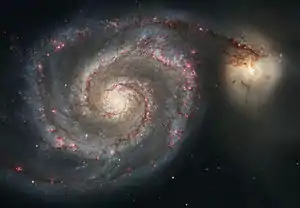 Whirlpool Galaxy (M51A or NGC 5194), the smaller object in the upper right is M51B or NGC 5195 | |
| Observation data (J2000 epoch) | |
| Constellation | Canes Venatici[1] |
| Right ascension | 13h 29m 52.7s[2] |
| Declination | +47° 11′ 43″[2] |
| Redshift | 0.001544[2] |
| Distance | 31 Mly[3] |
| Apparent magnitude (V) | 8.4[4] |
| Characteristics | |
| Type | SA(s)bc pec[2] |
| Size | 76,000 light-years in diameter |
| Apparent size (V) | 11′.2 × 6′.9[2] |
| Notable features | Interacting with NGC 5195[5] |
| Other designations | |
| Question Mark Galaxy,[2] Rosse's Galaxy,[2] M51a,[2] NGC 5194,[2] UGC 8493,[2] PGC 47404,[2] VV 001a,[2] VV 403,[2] Arp 85,[2] GC 3572[2] | |
The galaxy and its companion, NGC 5195,[10] are easily observed by amateur astronomers, and the two galaxies may be seen with binoculars.[11] The Whirlpool Galaxy has been extensively observed by professional astronomers, who study it to understand galaxy structure (particularly structure associated with the spiral arms) and galaxy interactions.
Discovery
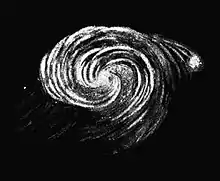
What later became known as the Whirlpool Galaxy was discovered on October 13, 1773, by Charles Messier while hunting for objects that could confuse comet hunters, and was designated in Messier's catalogue as M51.[12] Its companion galaxy, NGC 5195, was discovered in 1781 by Pierre Méchain, although it was not known whether it was interacting or merely another galaxy passing at a distance. In 1845, William Parsons, 3rd Earl of Rosse, employing a 72-inch (1.8 m) reflecting telescope at Birr Castle, Ireland, found that the Whirlpool possessed a spiral structure, the first "nebula" to be known to have one.[13] These "spiral nebulae" were not recognized as galaxies until Edwin Hubble was able to observe Cepheid variables in some of these spiral nebulae, which provided evidence that they were so far away that they must be entirely separate galaxies.[14]
The advent of radio astronomy and subsequent radio images of M51 unequivocally demonstrated that the Whirlpool and its companion galaxy are indeed interacting. Sometimes the designation M51 is used to refer to the pair of galaxies, in which case the individual galaxies may be referred to as M51a (NGC 5194) and M51b (NGC 5195).
Visual appearance
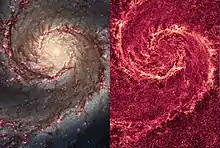
Deep in the constellation Canes Venatici, M51 is often found by finding the easternmost star of the Big Dipper, Eta Ursae Majoris, and going 3.5° southwest. Its declination is, rounded, +47°, making it circumpolar (never setting) for observers above the 43rd parallel north;[lower-alpha 1] it reaches a high altitude throughout this hemisphere making it an accessible object from the early hours in November through to the end of May, after which observation is more coincidental in modest latitudes with the risen sun (due to the Sun approaching to and receding from its right ascension, specifically figuring in Gemini, just to the north).
M51 is visible through binoculars under dark sky conditions, and it can be resolved in detail with modern amateur telescopes.[11] When seen through a 100 mm telescope the basic outlines of M51 (limited to 5×6') and its companion are visible. Under dark skies, and with a moderate eyepiece through a 150 mm telescope, M51's intrinsic spiral structure can be detected. With larger (>300 mm) instruments under dark sky conditions, the various spiral bands are apparent with HII regions visible, and M51 can be seen to be attached to M51B.
As is usual for galaxies, the true extent of its structure can only be gathered from inspecting photographs; long exposures reveal a large nebula extending beyond the visible circular appearance. In 1984, thanks to the high-speed detector—the so-called image-photon-counting system (IPCS)—developed jointly by the CNRS Laboratoire d'Astronomie Spatiald (L.A.S.-CNRS) and the Observatoire de Haute Provence (O.H.P.) along with the particularly nice seeing offered by the Canada-France-Hawaii-Telescope (C.F.H.T.) 3.60m Cassegrain focus at Mauna Kea summit in Hawaii, Hua et al. detected the double component of the very nucleus of the Whirlpool galaxy.[15]
In January 2005 the Hubble Heritage Project constructed a 11,477 × 7,965-pixel composite image (shown in the infobox above) of M51 using Hubble's ACS instrument. The image highlights the galaxy's spiral arms, and shows detail into some of the structures inside the arms.[16]

a) 0.4; 0.7 μm – b) vis-blue/green; ir-red – c) 3.6; 4.5; 8 μm – d) 24 μm
Properties
The Whirlpool Galaxy lies 31 million light-years from Earth and has an estimated diameter of 76,000 light-years.[17] Overall the galaxy is about 43% the size of the Milky Way. Its mass is estimated to be 160 billion solar masses,[18] or around 10.3% of the mass of Milky Way Galaxy.
A black hole, once thought to be surrounded by a ring of dust, but now believed to be partially occluded by dust instead, exists at the heart of the spiral. A pair of ionization cones extend from the active galactic nucleus.[19]
Spiral structure
The pronounced spiral structure of the Whirlpool Galaxy is believed to be the result of the close interaction between it and its companion galaxy NGC 5195, which may have passed through the main disk of M51 about 500 to 600 million years ago. In this proposed scenario, NGC 5195 came from behind M51 through the disk towards the observer and made another disk crossing as recently as 50 to 100 million years ago until it is where we observe it to be now, slightly behind M51.[20]
Star formation
The central region of M51 appears to be undergoing a period of enhanced star formation. The present efficiency of star formation, defined as the ratio of mass of new stars to the mass of star-forming gas, is only ~1%, quite comparable to the global value for the Milky Way and other galaxies. It is estimated that the current high rate of star formation can last no more than another 100 million years or so.[21]
Transient events
Three supernovae have been observed in the Whirlpool Galaxy:[22]
In 1994, SN 1994I was observed in the Whirlpool Galaxy. It was classified as type Ic, indicating that its progenitor star was very massive and had already shed much of its mass, and its brightness peaked at apparent magnitude 12.91.[23]
In June 2005 the type II supernova SN 2005cs was observed in the Whirlpool Galaxy, peaking at apparent magnitude 14.[24][25]
On 31 May 2011 a type II supernova was detected in the Whirlpool Galaxy, peaking at magnitude 12.1.[26] This supernova, designated SN 2011dh, showed a spectrum much bluer than average, with P Cygni profiles, which indicate rapidly expanding material, in its hydrogen-Balmer lines.[27] The progenitor was probably a yellow supergiant[28] and not a red or blue supergiant, which are thought to be the most common supernova progenitors.
On 22 January 2019, a supernova impostor, designated AT2019abn, was discovered in Messier 51. The transient was later identified as a luminous red nova. The progenitor star was detected in archival Spitzer Space Telescope infrared images. No object could be seen at the position of the transient in archival Hubble images, indicating that the progenitor star was heavily obstructed by interstellar dust. 2019abn peaked at magnitude 17, reaching an intrinsic brightness of .[29]
Planet candidate
In September 2020, the detection by the Chandra X-ray Observatory[30] of a candidate exoplanet, named M51-ULS-1b, orbiting the high-mass X-ray binary M51-ULS-1 in this galaxy was announced. If confirmed, it would be the first known instance of an extragalactic planet, a planet outside the Milky Way Galaxy. The planet candidate was detected by eclipses of the X-ray source (XRS), which consists of a stellar remnant (either a neutron star or a black hole) and a massive star, likely a B-type supergiant. The planet would be slightly smaller than Saturn and orbit at a distance of some tens of astronomical units.[31][32]
Companion
NGC 5195 (also known as Messier 51b or M51b) is a dwarf galaxy that is interacting with the Whirlpool Galaxy (also known as M51a or NGC 5194). Both galaxies are located approximately 31 million light-years away in the constellation Canes Venatici. Together, the two galaxies are one of the most widely studied interacting galaxy pairs.
Galaxy group information
The Whirlpool Galaxy is the brightest galaxy in the M51 Group, a small group of galaxies that also includes M63 (the Sunflower Galaxy), NGC 5023, and NGC 5229.[33][34][35][36] This small group may actually be a subclump at the southeast end of a large, elongated group that includes the M101 Group and the NGC 5866 Group, although most group identification methods and catalogs identify the three groups as separate entities.[37]
Gallery
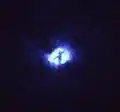 A 1992 Hubble image showing a knot of dust once thought to be a pair of rings encircling a black hole
A 1992 Hubble image showing a knot of dust once thought to be a pair of rings encircling a black hole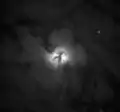 A 2005 Hubble image showing details of the dust at the nucleus of M51
A 2005 Hubble image showing details of the dust at the nucleus of M51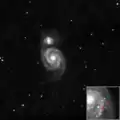 Supernova impostor AT2019abn, imaged at Northolt Branch Observatories in March 2019
Supernova impostor AT2019abn, imaged at Northolt Branch Observatories in March 2019 Supernova impostor AT2019abn, imaged by the Hubble Space Telescope
Supernova impostor AT2019abn, imaged by the Hubble Space Telescope Amateur astrophotographer's image taken in 2022 of Whirlpool Galaxy
Amateur astrophotographer's image taken in 2022 of Whirlpool Galaxy
See also
- List of Messier objects
- List of galaxies
- Messier object
- Messier 101 – another grand-design spiral galaxy
- New General Catalogue
- NGC 5195 – the companion galaxy to NGC 5194
References and footnotes
- Dreyer, J. L. E. (1988). Sinnott, R. W. (ed.). The Complete New General Catalogue and Index Catalogue of Nebulae and Star Clusters. Sky Publishing Corporation/Cambridge University Press. ISBN 978-0-933346-51-2.
- "NASA/IPAC Extragalactic Database". Results for NGC 5194. Retrieved December 6, 2006.
- "Messier 51 (The Whirlpool Galaxy)". 6 October 2017.
- "M51". SEDS.org.
- Elmegreen, D. M.; Elmegreen, B. G. (1987). "Arm classifications for spiral galaxies". Astrophysical Journal. 314: 3–9. Bibcode:1987ApJ...314....3E. doi:10.1086/165034.
- Arp, H. (1966). "Atlas of Peculiar Galaxies". Astrophysical Journal Supplement. 14: 1. Bibcode:1966ApJS...14....1A. doi:10.1086/190147.
- Matsushita, Satoki; Muller, Sebastien; Lim, Jeremy (9 April 2007). "Jet-disturbed molecular gas near the Seyfert 2 nucleus in M51". Astronomy & Astrophysics. 468 (A&A Letters Special Issue): L49–L52. arXiv:0704.0947. Bibcode:2007A&A...468L..49M. doi:10.1051/0004-6361:20067039. S2CID 15471799.
- "Whirlpool Galaxy: First Spiral Galaxy". Universe for Facts. Retrieved 21 December 2014.
- Garner, Rob (2017-10-06). "Messier 51 (The Whirlpool Galaxy)". NASA. Retrieved 2021-01-20.
- "M 51". 2016-10-10.
- Nemiroff, R.; Bonnell, J., eds. (February 24, 2013). "M51: The Whirlpool Galaxy". Astronomy Picture of the Day. NASA. Retrieved October 11, 2018.
- Messier, Charles (1781). "Catalogue des Nébuleuses & des amas d'Étoiles". Connaissance des Temps [1784]. pp. 227–267 [246].
- Rosse revealed the spiral structure of Whirlpool galaxy (M51) at the 1845 meeting of the British Association for the Advancement of Science. Rosse's illustration of M51 was reproduced in J.P. Nichol's book of 1846.
- Rosse, Earl of (1846). "On the nebula 25 Herschel, or 61 [should read: 51] of Messier's catalogue". Report of the Fifteenth Meeting of the British Association for the Advancement of Science; Held at Cambridge in June 1845 § Notices and Abstracts of Miscellaneous Communications to the Sections. Report of the ... Meeting of the British Association for the Advancement of Science (1833): 4.
- Nichol, John Pringle (1846). Thoughts on Some Important Points Relating to the System of the World. Edinburgh, Scotland: William Tait. p. 23. Rosse's illustration of the Whirlpool galaxy appears on the plate that immediately precedes p. 23.
- Hubble, E. P. (1929). "A spiral nebula as a stellar system, Messier 31". Astrophysical Journal. 69: 103–158. Bibcode:1929ApJ....69..103H. doi:10.1086/143167.
- Hua; et al. (1987). Astrophysical Letters and Communications. 25: 187–204. OCLC 60627567.
{{cite journal}}: Missing or empty|title=(help) - "Out of This Whirl: The Whirlpool Galaxy (M51) and Companion Galaxy". News Center. HubbleSite. April 25, 2005. Retrieved August 7, 2006.
- "Hubble's Messier Catalogue – Messier 51 (The Whirlpool Galaxy)". NASA. October 17, 2017. Retrieved September 6, 2021.
- "Whirlpool Galaxy". Herschel Space Observatory. Cardiff University. June 19, 2009. Retrieved October 11, 2018.
- "NASA's Hubble Space Telescope Resolves a Dark "x" Across the Nucleus of M51". News Center. HubbleSite. June 8, 1992. Retrieved August 7, 2006.
- Salo, Heikki; Laurikainen, Eija (1999). "A Multiple Encounter Model of M51". Astrophysics and Space Science. 269: 663–664. Bibcode:1999Ap&SS.269..663S. doi:10.1023/A:1017002909665. S2CID 189838328.
- Thronson, Harley A.; Greenhouse, Matthew A. (1988). "Near-Infrared Mass-to-light ratios in Galaxies: Stellar Mass and Star Formation in the Heart of the Whirlpool". The Astrophysical Journal. 327: 671–679. Bibcode:1988ApJ...327..671T. doi:10.1086/166224.
- "List of Supernovae". Central Bureau for Astronomical Telegrams. Retrieved February 27, 2016.
- Sauer, D. N.; Mazzali, P. A.; Deng, J.; Valenti, S.; et al. (2006). "The properties of the 'standard' Type Ic supernova 1994I from spectral models". Monthly Notices of the Royal Astronomical Society. 369 (4): 1939–1948. arXiv:astro-ph/0604293. Bibcode:2006MNRAS.369.1939S. doi:10.1111/j.1365-2966.2006.10438.x. S2CID 119510845.
- MacRobert, Alan M. (August 24, 2005). "Supernova in M51". Sky Tonight. Sky and Telescope. Retrieved August 7, 2006.
- Bishop, David. "Supernova 2005cs in M51". supernovae.net. Archived from the original on October 3, 2006. Retrieved August 7, 2006.
- Bishop, David. "Supernovae 2011dh in M51". supernovae.net (International Supernovae Network). Retrieved 2011-06-06.
- Kinne (kqr), Richard (2011-06-03). "AAVSO Special Notice #241: New Supernova in M51". AAVSO. Retrieved 2011-06-06.
- "ATEL 3401: Properties of the Candidate Progenitor of SN 2011dh in M51". Astronomers Telegram. 2011-06-03. Retrieved 2011-06-06.
- Jacob E. Jencson; Scott M. Adams; Howard E. Bond (2019). "Discovery of an intermediate-luminosity red transient in M51 and its likely dust-obscured, infrared-variable progenitor". The Astrophysical Journal Letters. 880 (L20): L20. arXiv:1904.07857. Bibcode:2019ApJ...880L..20J. doi:10.3847/2041-8213/ab2c05. S2CID 119110002.
- "Signs of first planet found outside our galaxy". BBC News. 2021-10-25. Archived from the original on 2021-10-25.
- Crane, Leah (23 September 2020). "Astronomers may have found the first planet in another galaxy". New Scientist. Retrieved 25 September 2020.
- Di Stefano, Rosanne; Berndtsson, Julia; Urquhart, Ryan; Soria, Roberto; Kashyap, Vinay L.; Carmichael, Theron W.; Imara, Nia (2021-10-25). "A possible planet candidate in an external galaxy detected through X-ray transit". Nature Astronomy. 5 (12): 1297–1307. arXiv:2009.08987. Bibcode:2021NatAs...5.1297D. doi:10.1038/s41550-021-01495-w. ISSN 2397-3366. S2CID 239892362.
- Tully, R. B. (1988). Nearby Galaxies Catalog. Cambridge University Press. ISBN 978-0-521-35299-4.
- Fouque, P.; Gourgoulhon, E.; Chamaraux, P.; Paturel, G. (1992). "Groups of galaxies within 80 Mpc. II - The catalogue of groups and group members". Astronomy and Astrophysics Supplement. 93: 211–233. Bibcode:1992A&AS...93..211F.
- Garcia, A. (1993). "General study of group membership. II – Determination of nearby groups". Astronomy and Astrophysics Supplement. 100: 47–90. Bibcode:1993A&AS..100...47G.
- Giuricin, G.; Marinoni, C.; Ceriani, L.; Pisani, A. (2000). "Nearby Optical Galaxies: Selection of the Sample and Identification of Groups". Astrophysical Journal. 543 (1): 178–194. arXiv:astro-ph/0001140. Bibcode:2000ApJ...543..178G. doi:10.1086/317070. S2CID 9618325.
- Ferrarese, L.; Ford, H. C.; Huchra, J.; Kennicutt Jr., R. C.; et al. (2000). "A Database of Cepheid Distance Moduli and Tip of the Red Giant Branch, Globular Cluster Luminosity Function, Planetary Nebula Luminosity Function, and Surface Brightness Fluctuation Data Useful for Distance Determinations". Astrophysical Journal Supplement. 128 (2): 431–459. arXiv:astro-ph/9910501. Bibcode:2000ApJS..128..431F. doi:10.1086/313391. S2CID 121612286.
- 47 out of 90 degrees north of the celestial equator. Thus its light emits as far south, to a good minimal cumulation of 15° above the horizon, once a day, on the 28th parallel south.
External links
- StarDate: M51 Fact Sheet
- M51: Calar Alto Observatory
- SEDS: Spiral Galaxy M51
- NASA Astronomy Picture of the Day: M51: The Whirlpool Galaxy in Dust and Stars (10 April 2001)
- Whirlpool Galaxy at ESA/Hubble
- The Whirlpool Galaxy (Messier 51(a)/NGC 5194)
- M51 The Whirlpool Galaxy
- The Whirlpool Galaxy at Constellation Guide
- The Whirlpool Galaxy on WikiSky: DSS2, SDSS, GALEX, IRAS, Hydrogen α, X-Ray, Astrophoto, Sky Map, Articles and images
- The Whirlpool Galaxy in the Staracle Messier catalog
